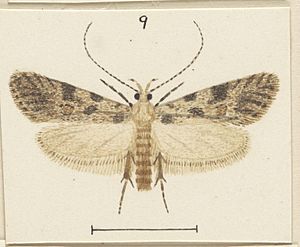Izatha rigescens facts for kids
Quick facts for kids Izatha rigescens |
|
|---|---|
 |
|
| Scientific classification | |
| Kingdom: | |
| Phylum: | |
| Class: | |
| Order: | |
| Family: |
Oecophoridae
|
| Genus: | |
| Species: |
I. rigescens
|
| Binomial name | |
| Izatha rigescens Meyrick, 1929
|
|
Izatha rigescens is a special kind of moth that belongs to the Oecophoridae family. It is found only in New Zealand, meaning it is endemic there. This moth is quite rare and mysterious.
Scientists have given it a "Data Deficient" conservation status. This means they don't have enough information to know if it's in danger. The moth has only ever been found along the Wellington coast. Sadly, no one has seen this species since 1929.
Contents
Discovering This Moth
This moth was first described by a scientist named Edward Meyrick in 1929. He studied a male moth specimen. This specimen was collected by George Hudson in March. Hudson found it at a place called Point Howard in Lower Hutt.
Later, Hudson wrote about and drew pictures of the moth. This was in his 1939 book, A supplement to the butterflies and moths of New Zealand. The original specimen, called the holotype, is kept safe. You can find it at the Natural History Museum, London.
What Does It Look Like?
This moth is about 17 millimeters long. That's about the size of a small button. Its head and chest area are white mixed with grey. The special mouthparts, called palpi, are white too.
The front wings are long and slightly wider at the end. They are mostly grey-whitish with some grey speckles. There are also some blackish marks. The back wings are a pale brownish color.
I. rigescens can sometimes be confused with other moths. For example, I. gibbsi looks similar. But I. rigescens is more brownish. Its back wings are also much paler. It might also look like Thamnosara sublitella. However, I. rigescens has different mouthparts. This helps scientists tell them apart.
Where Does This Moth Live?
This moth is only found in New Zealand. It is truly unique to this country. So far, it has only been seen in one specific place. That place is Point Howard, Lower Hutt, which is in the Wellington region.
Life and Habits
Scientists do not know much about how this moth lives. We know that adult moths fly around in March. This is quite late in the season for moths. Because it flies so late, people might have missed seeing it. This could be why it is so hard to find.
What Does It Eat and Where Does It Live?
We don't know what the young moths, called larvae, eat. Scientists have some ideas. They think the larvae might eat dead wood. Other ideas are that they might feed on lichens. Or they could eat epiphytic mosses. These are plants that grow on other plants.
George Hudson found the only known moths of this species. He collected them by shaking coastal scrub. This was at Point Howard, where the moths were found.
Conservation Status
This moth has a "Data Deficient" conservation status. This is under the New Zealand Threat Classification System. "Data Deficient" means there isn't enough information. Scientists need more research to know if this moth is truly endangered. They need to find out how many there are and what threats they face.

